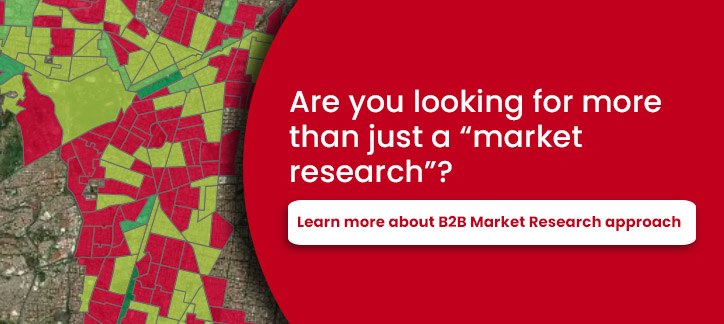What makes a product launch successful? Why do some companies remain leaders over the year? Why do some others fall due to unexpected market conditions? Short answer: Winning companies keep constant track of their market.
That is not an exception for industrial brands. Over the last decade, phenomena like Industry 4.0 and Smart Manufacturing have been the natural result of technological development. These have brought benefits but also significant challenges.
According to Deloitte’s industry outlook, the main challenges the manufacturing industry is facing right now are:
- Digital Adoption: Technology is changing fast. Manufacturers must invest in digital tools and tech-enabled processes, which aren’t always straightforward.
- Talent Shortage: Keeping good employees is a struggle. Even as new hires come in, many more are leaving. Companies must find ways to attract and keep skilled workers.
- Supply Chain Issues: Ongoing material shortages and disruptions pose a considerable risk. Solutions like digital tech and supply redundancy can help, but they’re not quick fixes to the overall issue.
- Transition to Smart Factories: Many experts consider the future is in Smart Factories. The challenge? It requires considerable investment and planning. While some manufacturers are starting this journey, it’s a complex process for most.
- Sustainability Requirements: ESG is becoming more severe. Manufacturers must adapt their operations to meet these regulations, which can be a tough balancing act.
Why is industrial market research more critical than ever?
These are challenging times for the overall industry, no doubt of that. Companies face fast-moving scenarios and complex challenges that demand strategic and precise decision-making with a clear vision for the future.
Businesses that want to remain competitive in this uncertain landscape must keep track of their market past the obvious. That is why a good market research analysis must help organizations achieve three main goals:
- Understand how the market is changing right now and how it will probably change.
- Identify the main opportunities that need to be approached.
- Detect threats that can put the company at risk.
The new way of doing Industrial Market Research
Market research is about collecting, analyzing, and extracting valuable insights from data. Now, data can come from many sources. From historical sales records and industry reports to IoT data and consumer analytics.
What is the problem with traditional market research?
Probably, when talking about market research, the first things that come into your mind are interviews, focus groups, and surveys. Yes, these tools are helpful to a certain degree, but you are missing many insights from other valuable sources.
The new industrial market research method involves Big Data, Machine Learning, and AI. What does this mean? Data-driven market research combines your internal record with alternative data like IoT, Foot traffic, Location Intelligence, Web scrapping, and more.
“Agile and adaptive techniques will replace older, and expensive approaches.”
Rivaltech, Market Research Trends
Here are three main benefits of data-driven market research:
Rich and Varied Data Sources: With a data-driven approach, you are not bound by a single source of information. On the contrary, you can expand your insight scope and get a 360-degree viewpoint of your market, consumers, and competitors by adding external and alternative data.
Robust Sample Sizes: One of the main pain points of traditional research is to capture an accurate picture of your target market based on limited sample sizes. On the other hand, data-driven analysis can better represent your market based on more extensive and reliable datasets.
Objectivity: Interpretation bias is a real issue with traditional research. In a data-driven scenario, you rely more on hard facts and numbers than personal judgments or predispositions. Conclusions are based on what the data tells you rather than what a pollster interprets. This significantly reduces the risk of making incorrect decisions.

Data-driven quantitative research
Quantitative research relies on “hard” numbers. A quantitative approach will help you identify new trends and make predictions based on customer segments, a geographic area, or a product.
Market research firms usually use surveys, polls, and questionaries to gather information. But imagine how many surveys you will need to accurately decide what cities will be best for testing a new product launch (For example).
“We are bombarded with surveys about every single experience. Brands are asking for feedback all the time, but they’re using outdated methods…”
Jason Jacobson, Director of Consumier Insights at Sekisui House
Using a data-driven approach, you can get consumer insights without intermediaries. For example, combining transaction data, POI data, consumer foot traffic, and web scraping in a predictive model allows you to identify key cities with higher concentrations of users willing to try your new product.
Data-driven qualitative research
Qualitative research focuses on non-numerical factors like consumer perceptions and emotions. Its main objective is to answer questions like, How many? How often? How much?
Qualitative research is helpful for marketing teams within industrial companies because it helps them align with the market’s language and approach consumers’ problems more precisely and quickly.
Now, how can a data-driven approach help marketers get real insights from users? Big Data tools, including customer analytics, web scraping, text mining, sentiment analysis, social media analysis, and mobile data, are crucial to understanding consumers beyond what they can tell you in an interview or a focus group.
Benefits of conducting a Data-Driven market research for your industrial company
Data-driven solution for a customer-centric approach
Whether you are a B2B or a B2C organization doesn’t matter, you should always focus on your customer. As we mentioned before, a data-driven approach will help you dig into your target consumers’ actual pain points by analyzing not only what they say but do.
Monitoring your competitors’ strategy
- For most industrial industries, having a close look at competitors is a must. But how? Data-driven approaches like our AI-competitive intelligence tool, or our Supply Chain Mapping tool can help you answer questions like:
- Which are the main providers of my top competitors?
- Are my suppliers also doing business with my competition?
- What are their sales strategies?
- Which companies are underserved by my competition?
Product development
Developing products is expensive and time-consuming in most cases. That is why your product development must confirm that their concept has value and refine the process over time.
“Only 40% of new products are still sold after three years.”
MIT Sloan
Many products fail because the market has shifted, and the new product does not meet the user’s needs. Conducting data-driven market research can reduce the risk of launching an underperforming new product.
Innovation
“Innovation” is a central concept in the industry market. Innovation helps companies stay ahead and is the fuel for constant growth.
By showing new trends and patterns, data-driven market research can provide you with all the necessary elements to take action before anyone else within your market. Remember: Being second is to be the first of the ones who lose.
Become top player in your market
Are you seeking specialized market research to analyze your target market, customer research, competitive analysis, market size research, economic insights, or risk analysis? We got the data-driven approach you are looking for.
We have worked with more than 50 different industries. Our objective is to make your business stand out in your industry.







